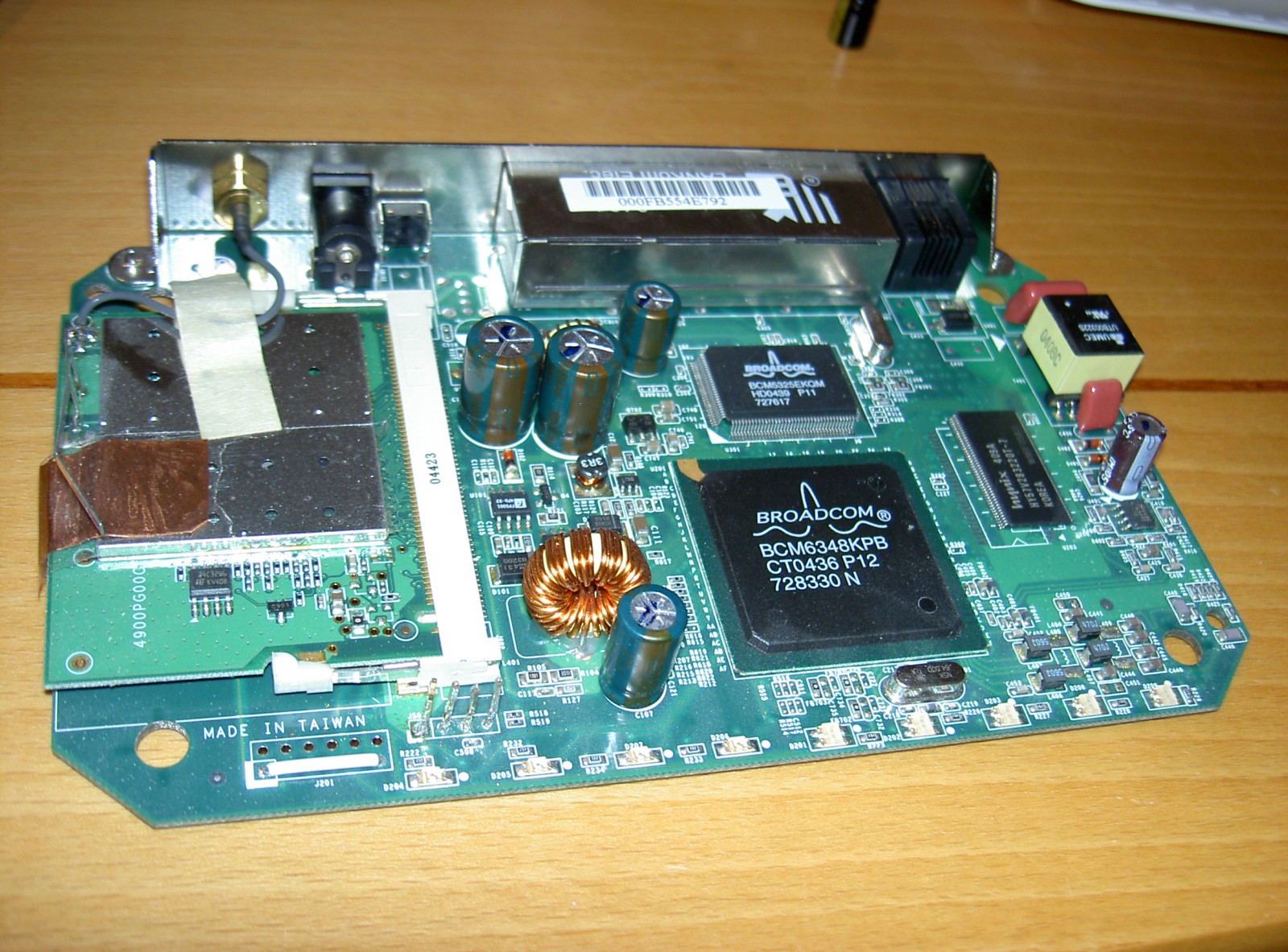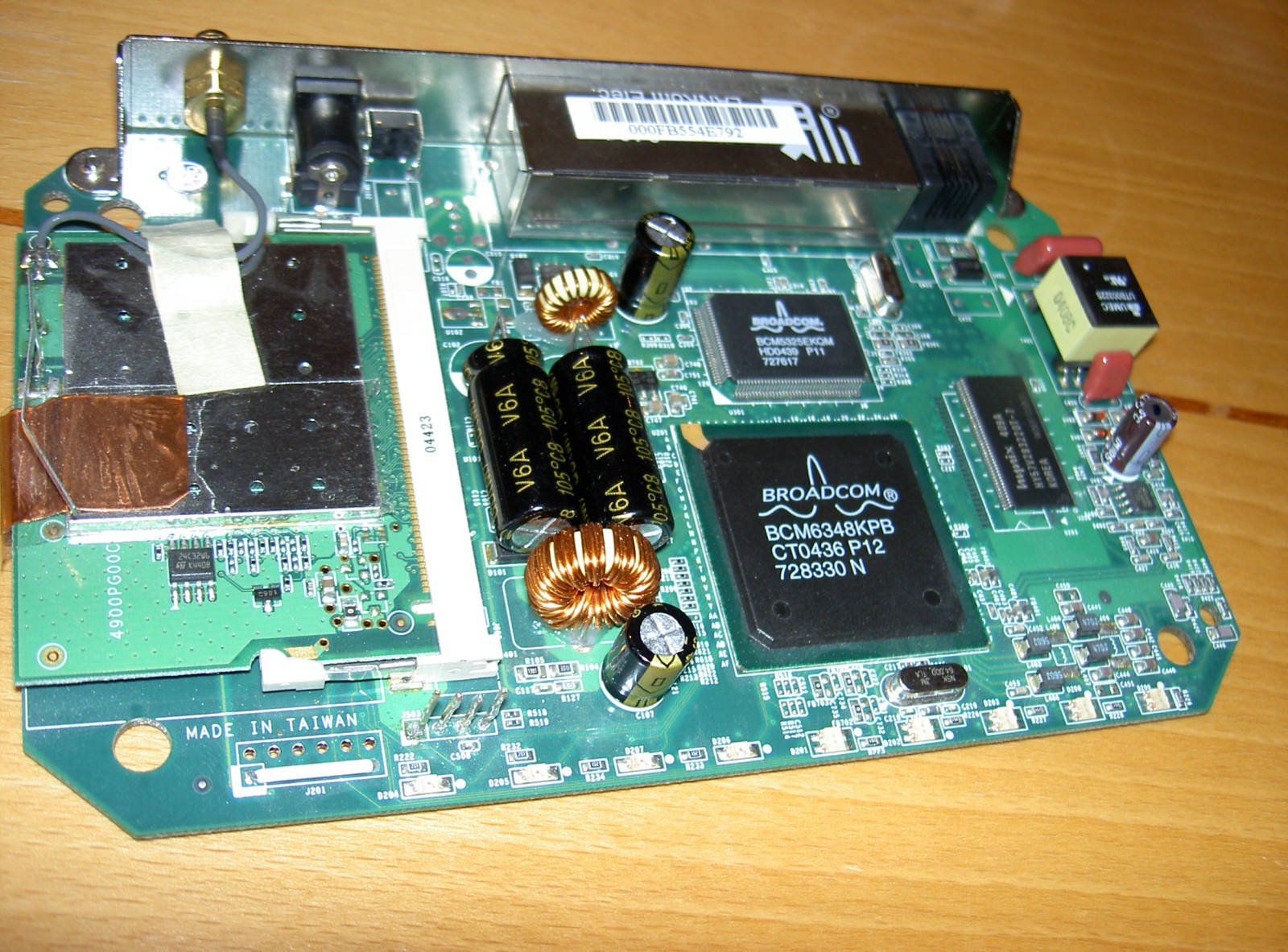This is a small router I've both hated and loved
Story goes a friend called me some years ago and asked what router to buy, I had read good things about the DG834GT back then (this was just when it was released)
So I advised him to buy it
Now a compatibility problem with his ISP's DSLAM caused it unable to get an IP Address, I first brought it up with Netgear and they where very responsive, sending me unreleased BETA firmwares and so on, but it did not help
So I hacked the router myself, compiled a new firmware for it with a more recent dhcp client, hoping that would allow it to get an IP, but it did not, in the process that also caused a problem in that the firmware could after that not be flashed via the webinterface, so I had to connect it up internally via RS422 serial to flash directly from the CFE...
So for every subsequent upgrade of the routers firmware I had to bring out my Linux Compilation toolchain for the DG834GT and compile it just so I could get the firmware that the CFE flash needed...
After a while a firmware that did work with Ericssons DSLAM's was released
But not by Netgear but instead a guy like me that got hold of a more recent ADSL driver for the router... The name of that firmware was UberGT
That worked really well and he ran it with that for about 2 or 3 years now
Out of boredom (and because of my 4 weeks vacation) I decided to give it another go, because the old UberGT project was cancelled due to an even more capable firmware being released by a project called DGTeam.
I was not able to flash the firmware with the webinterface but could use the recovery utility with the excellent instructions on this page, so no need to start compiling stuff again
After installing the firmware and starting the router up again there was allot of more settings offered by the new firmware.
I ran some performance tests and while maxing a 24mbps ADSL line (synced at 23mbps down and 2.3mbps up) downloading linux ISO files with µTorrent, loads where generally acceptable below 1.0
But the interface did feel quite slow, and I did get disconnected via telnet a few times when checking loads and RAM usage, the download speed was not affected tho...
Anyway I left the router be but next day he called me and said the router was really hot, so I thought either the new firmware had a bug causing 100% CPU load (which I did not notice when I was there because idle it's load average was like 0.01) or it was "the other problem"
So I asked him to bring it over and sure enough;


One of the 2x TEAPO SC 1000uF 16v caps had vented, replaced them with Samxon GD 2200uF 16v caps, did not have more suitable caps in stock though I'm sure the extra bulk capacitance will just be good
There was 1x TEAPO SC 1000uF 6.3v cap, this I replaced with Samxon GC 1000uF 6.3v
And 1x TEAPO 470uF 16v replaced with Samxon GC 470uF 16v
The lone capacitor on the right of the PCB is a UCC and still had good ESR so I left it in place
After this I did a new performance test, downloading the same linux ISO so maxing the router, also surfing and listening to webradio at the same time
The router held up good, no disconnects on Telnet and load seemed to be lower (around 0.5 instead of 1.0)
So I guess it does make a performance difference to have caps that are actually able to filter the current for the processor
Story goes a friend called me some years ago and asked what router to buy, I had read good things about the DG834GT back then (this was just when it was released)
So I advised him to buy it
Now a compatibility problem with his ISP's DSLAM caused it unable to get an IP Address, I first brought it up with Netgear and they where very responsive, sending me unreleased BETA firmwares and so on, but it did not help
So I hacked the router myself, compiled a new firmware for it with a more recent dhcp client, hoping that would allow it to get an IP, but it did not, in the process that also caused a problem in that the firmware could after that not be flashed via the webinterface, so I had to connect it up internally via RS422 serial to flash directly from the CFE...
So for every subsequent upgrade of the routers firmware I had to bring out my Linux Compilation toolchain for the DG834GT and compile it just so I could get the firmware that the CFE flash needed...
After a while a firmware that did work with Ericssons DSLAM's was released
But not by Netgear but instead a guy like me that got hold of a more recent ADSL driver for the router... The name of that firmware was UberGT
That worked really well and he ran it with that for about 2 or 3 years now
Out of boredom (and because of my 4 weeks vacation) I decided to give it another go, because the old UberGT project was cancelled due to an even more capable firmware being released by a project called DGTeam.
I was not able to flash the firmware with the webinterface but could use the recovery utility with the excellent instructions on this page, so no need to start compiling stuff again
After installing the firmware and starting the router up again there was allot of more settings offered by the new firmware.
I ran some performance tests and while maxing a 24mbps ADSL line (synced at 23mbps down and 2.3mbps up) downloading linux ISO files with µTorrent, loads where generally acceptable below 1.0
But the interface did feel quite slow, and I did get disconnected via telnet a few times when checking loads and RAM usage, the download speed was not affected tho...
Anyway I left the router be but next day he called me and said the router was really hot, so I thought either the new firmware had a bug causing 100% CPU load (which I did not notice when I was there because idle it's load average was like 0.01) or it was "the other problem"
So I asked him to bring it over and sure enough;
One of the 2x TEAPO SC 1000uF 16v caps had vented, replaced them with Samxon GD 2200uF 16v caps, did not have more suitable caps in stock though I'm sure the extra bulk capacitance will just be good
There was 1x TEAPO SC 1000uF 6.3v cap, this I replaced with Samxon GC 1000uF 6.3v
And 1x TEAPO 470uF 16v replaced with Samxon GC 470uF 16v
The lone capacitor on the right of the PCB is a UCC and still had good ESR so I left it in place
After this I did a new performance test, downloading the same linux ISO so maxing the router, also surfing and listening to webradio at the same time
The router held up good, no disconnects on Telnet and load seemed to be lower (around 0.5 instead of 1.0)
So I guess it does make a performance difference to have caps that are actually able to filter the current for the processor

Comment